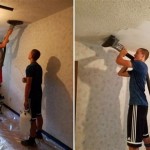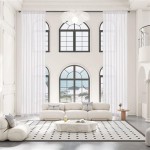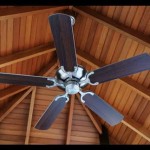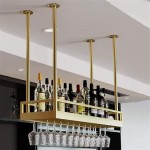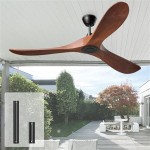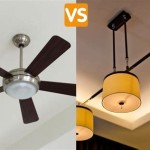Ceiling Fans and Recessed Lights: A Comprehensive Guide to Complementary Lighting Solutions
Ceiling fans and recessed lights represent two distinct yet frequently combined lighting and comfort solutions for residential and commercial spaces. Understanding their individual functionalities, benefits, and integration strategies is crucial for creating well-lit, comfortable, and energy-efficient environments. This article provides a detailed exploration of ceiling fans and recessed lights, examining their features, applications, and the factors to consider when incorporating them into a design plan.
Ceiling fans primarily serve to circulate air, offering cooling effects in warmer months and helping to distribute heat during colder seasons. Recessed lights, on the other hand, provide focused or ambient illumination, enhancing visibility and contributing to the aesthetic appeal of a room. The synergy between these two elements lies in their ability to address both the thermal comfort and lighting needs of a space, resulting in a more functional and pleasant environment.
Understanding Ceiling Fans: Features and Functionality
Ceiling fans consist of a motor housing, fan blades, and often, an integrated light fixture. The motor drives the blades, creating airflow that can be adjusted based on the desired comfort level. The direction of blade rotation is typically reversible, allowing for downdraft in the summer for cooling and updraft in the winter to redistribute warm air trapped near the ceiling.
The size and pitch of the fan blades are critical factors influencing the fan's performance. Larger blades generally move more air, while the pitch determines the angle at which the blades push the air downwards. Choosing the appropriate blade size and pitch is essential for achieving optimal airflow in a specific room size. Manufacturers provide guidelines based on square footage to assist in selecting the right fan for a given space.
Ceiling fans are available in a variety of styles, ranging from traditional to modern, and can be customized with different blade finishes, motor housings, and light fixture designs. This versatility allows homeowners and designers to select fans that complement the overall decor of the room. The integrated light fixtures can range from single bulbs to elaborate multi-light arrangements, providing both ambient and task lighting options.
Considerations for ceiling fan selection include the ceiling height, room size, and desired airflow. For rooms with low ceilings, flush-mount fans, also known as hugger fans, are recommended to maximize headroom. In larger rooms, multiple fans or larger fans with longer blades may be necessary to provide adequate air circulation. The noise level of the fan motor is another important factor, particularly for bedrooms and other quiet spaces. Selecting a fan with a high-quality motor and balanced blades can minimize noise and vibration.
Energy efficiency is a key benefit of ceiling fans. By circulating air, fans can reduce the reliance on air conditioning in the summer and heating in the winter, leading to significant energy savings. Look for fans with the Energy Star label, which indicates that the fan meets specific energy efficiency standards. These fans often feature more efficient motors and optimized blade designs, resulting in lower energy consumption.
Installation of ceiling fans typically requires electrical wiring and structural support. It is generally recommended to have a qualified electrician install the fan to ensure safe and reliable operation. Proper wiring, secure mounting, and balanced blades are essential for preventing hazards and maximizing the lifespan of the fan. Regular cleaning of the blades is also necessary to maintain optimal performance and prevent dust accumulation.
Exploring Recessed Lights: Types and Applications
Recessed lights, also known as can lights or downlights, are fixtures installed into the ceiling, providing illumination without protruding into the room. They consist of a housing, a trim, and a light source, which can be incandescent, halogen, LED, or compact fluorescent (CFL). The housing is the portion of the fixture that is installed within the ceiling cavity, while the trim is the visible portion that surrounds the light source.
Recessed lights offer a clean and minimalist aesthetic, making them a popular choice for modern and contemporary designs. They provide a versatile lighting solution that can be used for general ambient lighting, task lighting, or accent lighting. By strategically positioning recessed lights, it is possible to create a well-lit and visually appealing space.
There are several types of recessed lights, each with its own characteristics and applications. Standard recessed lights provide general illumination and are typically used for ambient lighting. Baffle trims feature a series of concentric rings inside the trim to reduce glare and provide a softer light. Reflector trims use a reflective surface to direct the light downwards, providing a brighter and more focused beam. Adjustable or gimbal trims allow the light to be angled, making them ideal for highlighting artwork or architectural features.
The choice of light source for recessed lights depends on several factors, including energy efficiency, light output, color temperature, and lifespan. LED recessed lights are increasingly popular due to their high energy efficiency, long lifespan, and excellent color rendering. They consume significantly less energy than incandescent or halogen bulbs and produce less heat, making them a more sustainable lighting option. Incandescent and halogen bulbs, while less energy efficient, offer a warm and familiar light quality.
The spacing and placement of recessed lights are crucial for achieving optimal illumination. A common rule of thumb is to space recessed lights approximately half the ceiling height apart. For example, in a room with an 8-foot ceiling, the lights should be spaced about 4 feet apart. The actual spacing may vary depending on the desired light level, the type of trim used, and the reflectivity of the room's surfaces. It's important to consider the room's layout and intended use when determining the optimal placement of recessed lights.
Installation of recessed lights requires careful consideration of electrical wiring and ceiling construction. It is essential to follow local building codes and safety regulations when installing recessed lights. Insulated ceiling-rated (IC-rated) fixtures are required for installation in ceilings with insulation to prevent overheating and fire hazards. Non-IC-rated fixtures must be installed with a minimum clearance of 3 inches from insulation. It is generally recommended to have a qualified electrician install recessed lights to ensure safe and proper operation.
Dimmable recessed lights offer added flexibility in controlling the light level and creating different moods. Installing a dimmer switch allows homeowners to adjust the brightness of the lights to suit the activity or time of day. Dimmable LED recessed lights require compatible dimmer switches and are not always universally compatible with all dimmer types. Checking the manufacturer's specifications for compatibility is crucial to ensure proper dimming performance.
Integrating Ceiling Fans and Recessed Lights: Design Considerations
Combining ceiling fans and recessed lights requires careful planning to ensure a cohesive and functional lighting and comfort system. The placement of recessed lights should complement the fan's location, avoiding direct interference with the fan's airflow. Ideally, recessed lights should be positioned around the perimeter of the room or in specific areas where task lighting is needed, leaving the center of the ceiling open for the fan.
The style and finish of both the ceiling fan and recessed light trims should be coordinated to create a unified aesthetic. Matching the finishes of the fan blades, motor housing, and recessed light trims can create a cohesive look. Consider the overall decor of the room and select finishes that complement the existing color scheme and architectural style. For example, in a modern space, brushed nickel or matte black finishes may be appropriate, while in a traditional space, antique brass or oil-rubbed bronze finishes may be preferred.
Consider the color temperature of the light sources used in both the ceiling fan and recessed lights. Color temperature is measured in Kelvin (K) and describes the warmth or coolness of the light. Warmer light, with a lower Kelvin value (e.g., 2700K-3000K), creates a cozy and inviting atmosphere, while cooler light, with a higher Kelvin value (e.g., 4000K-5000K), provides a brighter and more energetic feel. Coordinating the color temperature of the lights can create a more harmonious and comfortable lighting environment.
The control systems for ceiling fans and recessed lights can be integrated to provide more convenient and efficient operation. Smart home systems allow for remote control of both the fan speed and light level, as well as scheduling and automation features. Integrating the control systems can simplify operation and enhance energy efficiency by allowing users to adjust the lighting and airflow based on their needs and preferences.
Energy efficiency should be a primary consideration when integrating ceiling fans and recessed lights. Opting for Energy Star-rated ceiling fans and LED recessed lights can significantly reduce energy consumption and lower utility bills. Consider installing dimmer switches for the recessed lights to further reduce energy usage and customize the lighting levels. Regularly cleaning the fan blades and replacing outdated light bulbs can also improve energy efficiency.
Safety is paramount when installing and operating ceiling fans and recessed lights. Ensure that the electrical wiring is properly installed and grounded. Use insulated ceiling-rated (IC-rated) recessed lights in ceilings with insulation. Securely mount the ceiling fan to a structural support in the ceiling. Regularly inspect the fan blades and light fixtures for any signs of damage or wear. Following these safety precautions can help prevent accidents and ensure the safe operation of the lighting and comfort system.
Professional consultation with a lighting designer or electrician can be beneficial when planning the integration of ceiling fans and recessed lights. A professional can provide expert advice on the optimal placement of lights, the selection of appropriate fixtures, and the proper installation techniques. Consulting with a professional can help ensure that the lighting and comfort system meets the specific needs of the space and complies with all applicable building codes and safety regulations.

Led Recessed Lighting Right Way

Recessed Lighting Gold Standard Electric

Lots Of Windows Ceiling Fan And Recessed Lights Are Great Additions Traditional Conservatory Dc Metro By Post Designers Builders Division Sundecks Inc Houzz Ie

Recessed Lighting Solutions For Living Rooms Entryways And Dining Ideas Advice Lamps Plus

Open Loft

Recessed Lighting Ambler Pa It S On Electrical

Recessed Lighting With Ceiling Fan I Just Can T Give Up The Way To Circulate Air Living Room

Ceiling Fan Installation San Diego Right Way Lighting

Recessed Lighting Florida Electrician In Charge Electric

Recessed Lights Bathroom Light Fixtures And Ceiling Fans Installed A M Electric Llc
Related Posts
